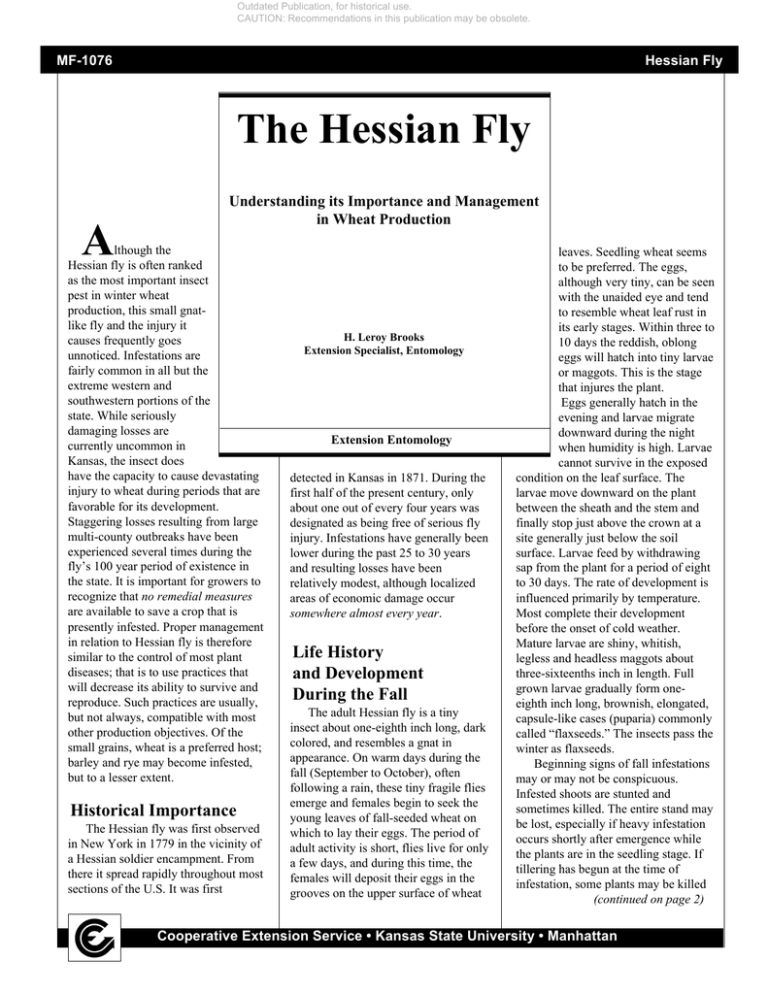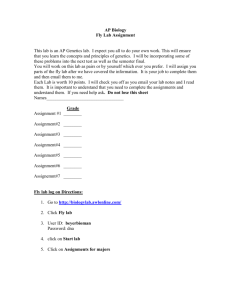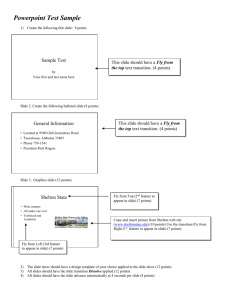A The Hessian Fly Understanding its Importance and Management in Wheat Production
advertisement

Outdated Publication, for historical use. CAUTION: Recommendations in this publication may be obsolete. 3 MF-1076 Hessian Fly The Hessian Fly A Understanding its Importance and Management in Wheat Production lthough the Hessian fly is often ranked as the most important insect pest in winter wheat production, this small gnatlike fly and the injury it causes frequently goes unnoticed. Infestations are fairly common in all but the extreme western and southwestern portions of the state. While seriously damaging losses are currently uncommon in Kansas, the insect does have the capacity to cause devastating injury to wheat during periods that are favorable for its development. Staggering losses resulting from large multi-county outbreaks have been experienced several times during the fly’s 100 year period of existence in the state. It is important for growers to recognize that no remedial measures are available to save a crop that is presently infested. Proper management in relation to Hessian fly is therefore similar to the control of most plant diseases; that is to use practices that will decrease its ability to survive and reproduce. Such practices are usually, but not always, compatible with most other production objectives. Of the small grains, wheat is a preferred host; barley and rye may become infested, but to a lesser extent. Historical Importance The Hessian fly was first observed in New York in 1779 in the vicinity of a Hessian soldier encampment. From there it spread rapidly throughout most sections of the U.S. It was first H. Leroy Brooks Extension Specialist, Entomology Extension Entomology detected in Kansas in 1871. During the first half of the present century, only about one out of every four years was designated as being free of serious fly injury. Infestations have generally been lower during the past 25 to 30 years and resulting losses have been relatively modest, although localized areas of economic damage occur somewhere almost every year. Life History and Development During the Fall The adult Hessian fly is a tiny insect about one-eighth inch long, dark colored, and resembles a gnat in appearance. On warm days during the fall (September to October), often following a rain, these tiny fragile flies emerge and females begin to seek the young leaves of fall-seeded wheat on which to lay their eggs. The period of adult activity is short, flies live for only a few days, and during this time, the females will deposit their eggs in the grooves on the upper surface of wheat leaves. Seedling wheat seems to be preferred. The eggs, although very tiny, can be seen with the unaided eye and tend to resemble wheat leaf rust in its early stages. Within three to 10 days the reddish, oblong eggs will hatch into tiny larvae or maggots. This is the stage that injures the plant. Eggs generally hatch in the evening and larvae migrate downward during the night when humidity is high. Larvae cannot survive in the exposed condition on the leaf surface. The larvae move downward on the plant between the sheath and the stem and finally stop just above the crown at a site generally just below the soil surface. Larvae feed by withdrawing sap from the plant for a period of eight to 30 days. The rate of development is influenced primarily by temperature. Most complete their development before the onset of cold weather. Mature larvae are shiny, whitish, legless and headless maggots about three-sixteenths inch in length. Full grown larvae gradually form oneeighth inch long, brownish, elongated, capsule-like cases (puparia) commonly called “flaxseeds.” The insects pass the winter as flaxseeds. Beginning signs of fall infestations may or may not be conspicuous. Infested shoots are stunted and sometimes killed. The entire stand may be lost, especially if heavy infestation occurs shortly after emergence while the plants are in the seedling stage. If tillering has begun at the time of infestation, some plants may be killed (continued on page 2) Cooperative Extension Service • Kansas State University • Manhattan Outdated Publication, for historical use. CAUTION: Recommendations in this publication may be obsolete. 24 while others survive. Examination of an infested plant will usually reveal an undeveloped central shoot with an unusually broad and thickened dark green leaf. To confirm the diagnosis, carefully remove the plant along with the roots from the soil and look closely for maggots or flaxseeds by gently pulling the leaf sheath away from the stem and inspecting carefully in the crown area. injury may be overcome, but the stem is usually weakened resulting in heads that are only partially filled and breakage just above the infested node. If infestation is severe, the stem may be killed outright. Low levels of infestation are not obvious and are frequently overlooked. Spring Infestation Supplementary Broods Emergence of adults that produce the spring brood may begin during late March, although peak emergence is usually during April. Females prefer young leaf blades for egg deposition. Now, the plants are usually jointing, much larger and better able to withstand the infestation. The point of attack by the spring maggots may be at the base of the plant, below the surface of the soil, or just above any of the nodes higher up on the stem. At the point of attack, the tissue of the stem appears to cease growth while the surrounding tissue continues to develop. This forms a niche just large enough for the maggot to lie in. The Adult Hessian Fly — about 1/8 inch long The generalized seasonal cycle includes the occurrence of a main spring brood, followed by flaxseed which lie dormant in the stubble until they emerge to produce the main fall brood. It is important, however, to recognize that a portion of the population fail to emerge as adults at any one period. Some of the flaxseeds survive in a dormant stage for weeks, months or in some cases even years. Hence, the exact source of a given infestation may be difficult to document. This also allows for additional broods to develop. The presence of volunteer wheat in or adjacent to infested fields allow for the development of a summer brood when weather conditions are favorable. The injury on the volunteer is usually of little consequence, but the individuals arising from this brood, may in turn produce a secondary fall brood that is likely to produce injury in planted wheat. (Secondary broods can develop from other sources as well). Here, damage is likely even though the fly-free date was followed at planting time. An additional brood is also sometimes observed in the spring. It usually occurs "Flaxseed" stage — about 1/8 inch later than the period of main infestation, and the point of attack is often higher up on the stems of the infested plants. Management Approaches 1. How to look for signs of infestation. Determining whether a problem exists and its seriousness if present is the first step. In the fall, check fields during late October and November, look for signs of infestations as previously described. Pay particular attention in early planted fields of susceptible varieties. Infestations may be greater in field margins adjacent to volunteer or stubble fields. Signs of damage early in the spring are not apt to be obvious unless infestations were high during the previous fall. Signs of spring infestation are best evaluated after the wheat is mature just prior to harvest. At this time, look mainly for signs of stem breakage. Stems that break over just above the node are particularly suspect. Closely examine behind the leaf sheath, just below the break, for signs of larvae or flaxseed. Look also for short undeveloped heads Outdated Publication, for historical use. CAUTION: Recommendations in this publication may be obsolete. 35 and tillers that are stunted or dead. Finding some signs of infestation (less than 5 percent of stems infested) is not unusual in the eastern two-thirds of the state. Infestations that average less than 10 percent of the stems infested with one flaxseed per stem would probably result in less than one bushel lost per acre; but losses increase rapidly at higher infestation levels and strongly signal the need for changes in production practices. 2. Destroy infested stubble. The fly population passes the period following harvest as flaxseeds in the stubble. Undisturbed stubble will favor the survival of the insects. Experience has shown that thorough incorporation of the stubble where soil erosion management practices allow can be a useful technique. Thorough incorporation must be stressed, however. In one study, flaxseeds buried one inch below the surface of the soil allowed 26 percent of the population to emerge; at two inches only 6 percent emerged and none emerged where the stubble was buried to a depth of four inches. In another similar study, it was determined that double discing was five times more effective than single discing. 3. What about burning and grazing? Studies have shown that burning will destroy those flaxseeds that are present on the above-ground portion of the stem. Usually, however, a high percentage occur at or below the soil line and burning will have little effect on the survival of these individuals. The effect from grazing would be somewhat similar. 4. Destroy volunteer. Volunteer that is allowed to grow for a period of two to three weeks can, especially in wet summers, enable the fly to produce an extra brood and carry it on in greater numbers to the regular crop. Thus, volunteer not only serves to increase the population, it may also render other practices, such as planting after the fly-free date, less effective. Keeping volunteer destroyed is also of vital importance in helping to keep wheat streak mosaic under control in areas where this disease is of concern. 5. Plant after the fly-free date. Observing the fly-free date means delaying planting until the fly-free date is reached for your location. Waiting Mature Larvae — about 3/16 in length until this date allows time for the main fall brood of adult Hessian flies to emerge and die before the wheat is planted. Without live wheat plants available, the emerging female flies are deprived on a place to lay their eggs, and the grower is therefore able to avoid fall infestation. There is still some risk if a nearby source of infestation exists, and if for some reason a secondary fall brood develops. Also, observance of the fly-free date does not necessarily prevent the possibility of spring infestation, although in most instances, it should help. The risk of fall infestation is almost always greater where wheat is planted before the fly-free date and especially during years that are favorable for fly development. The observance of the fly-free date also is a useful way to reduce the incidence of wheat streak mosaic. The fly-free dates are based on an average time of emergence and are the result of detailed observations made by research workers several years ago. As a result, the accuracy of this prediction will vary some from year to year. It may not always represent the best planting date for optimum yield, but on the average, it correlates quite well. The fly-free date may be used locally on a field by field basis, or during times of concern it will probably be more effective where it is practiced on an areawide or community-wide basis. 6. Planting too late is also risky. Growers may be surprised to learn that delaying planting too late in the fall can actually increase the risk of Hessian fly infestation. While late planting dates do protect the field against fall infestation, the result is smaller plants in the spring; and when the spring brood of flies are active in March or April, those females prefer younger plants for egg laying. Thus, if a source of infestation is nearby, very late planted wheat of a susceptible variety may suffer extensive damage from spring infestation. 7. Resistant varieties — perhaps the best answer! Often the best answer is to consider planting a resistant variety. Currently, our choices are more limited than we would prefer, yet growers should consider this option carefully during times when fly populations appear to be on the increase. It deserves special consideration where one plans to plant early for fall pasture, and where Outdated Publication, for historical use. CAUTION: Recommendations in this publication may be obsolete. 64 usefulness of other options are limited. A great number of factors must be considered in making varietal selections and since our options are limited, one factor must be weighed against others in making final determinations. A number of varieties carry good fly resistance. Detailed discussions on varietal performance is beyond the scope of this leaflet, thus we encourage you to consult with your county agent for additional information on performance of varieties in your locality. In addition, an Extension fact sheet, MF-991 should be consulted for the latest information on disease and Hessian fly ratings. Acknowledgements: Thanks to Jim Hatchett USDA Research Entomologist for suggestions and contributions; thanks also to Phil Sloderbeck, Don Mock, Bob Bauernfeind and George Lippert for reviewing and suggesting changes in the final manuscript. Cooperative Extension Service, Manhattan, Kansas Issued in furtherance of Cooperative Extension Work, acts of May 8 and June 30, 1914, as amended. Kansas State University, County Extension Councils, and United States Department of Agriculture Cooperating, Richard D. Wootton, Associate Director. All educational programs and materials available without discrimination of the basis of race, color, national origin, sex, age, or disability. Revised August 1993 File Code: Entomology—2, 1-85—5M; 10-85—5M; 8-93—5M





